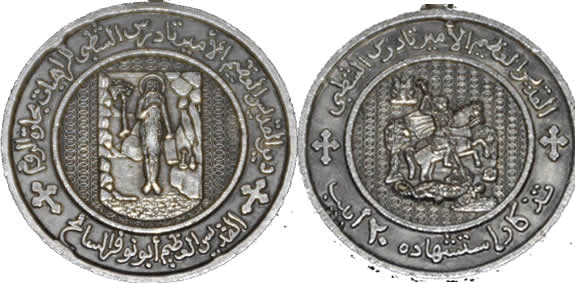This pendant was sent in by a visitor to Omniglot who would like to know whether anybody can decipher the inscription on it. It depicts St. George and the dragon and might be from Turkey.

Here’s my attempt to transcribe the inscriptions:
Left image top: ديرالقديس المقيم الأمير تادرس الشطي الهاتحارة الروم
Left image bottom: القديس الفطيم أبونوفاساح
Right image top: القديرا لعكيم الاميس تادرى الشطي
Right image bottom: تذكارإ ستشهاده ٦٠ أبيب
It’s Arabic. Here’s another transcription (in the same order):
دير القديس العظيم الأمير تادرس الشطبى للراهابت مجارة الروم
القديس العظيم أبونوفر السائح
القديرا العظيم الأمير تادرس السطبى
تذكار إستشهاده ٢٠ أبيب
In the first line the antipenultimate word is للرهبات (“to the nuns”) and the last word in the third line is الشطبى, my mistake.
It’s a coin commemorating the martyrdom of St. George (called “the great commander saint”), there’s somebody named Tādrus (Theodoros?), it’s “to the nuns” of a monastery (دير), and somebody is الشاطبي, which indicates provenance in the Valencian town of Xàtiva/Játiva.
Any other interpretations?
The date of the feast is given as the 20th of Abib/Epip, the Coptic summer month.
Ivan, thank you so much for your response to this. I find it interesting that this medallion has a Coptic influence and also a mention of a Valencian town. I’ve been trying to figure out the origins of the medallion as I have no idea how old it is and where it’s from. I was wondering if the inscription would give some hint as to its origins but it appears to have raised more questions than answers! Quite fascinating so far.
Is it commemorating St. George or St. Theodore? I just found this reference to feast day you mentioned, Ivan, with a similar print of St. Theodore slaying a serpent (strangely similar to St. George): http://www.facebook.com/note.php?note_id=218806170014
Hi,
We have received 495 nominations for The Top 100 Language Blogs 2010 competition. For each of the four categories we have admitted 100 blogs into the voting phase. Your blog is included for voting in the ‘Language Learning’ category. Congratulations!
As stated in our language blog Lexiophiles, 50% of the final score will be based on user votes. You can promote your blog by embedding a voting button in your page. The button code is available in the Lexiophiles blog. It can also be sent via email if you contact me.
The voting phase started on May 12th and ends on May 24th. Winners will be announced May 28th.
Good luck!
Priscila
on behalf of the bab.la and Lexiophiles team
I think that between us we’ve put it together. The adjective شطبي Šuṭubī here refers not to Xàtiva but to Shotep in Upper Egypt, that is to the Coptic St. Theodore of Shotep. (The Coptic origin would also account for the “Egyptian-style” orthography of the letter yā’ (as ى rather than the standard ي with two dots). The word أمير “amīr” can mean either “commander” or “prince,” and given the Synaxarion it would seem that it’s referring to a prince.
Having taken a second look at the writing (and gotten a good night’s sleep), here’s a better, clearer transcription:
دير القديس العظيم الأمير تادرس الشطبى للراهبات بحارة الروم
القديس العظيم أبونوفر السائح
القديس العظيم الأمير تادرس الشطبى
تذكار إستشهاده ٢٠ أبيب
, which plugged into Google Translate is a little clearer. My one major remaining qualm is about the bottom of the side shown on the left: سائح “sā’iḥ” in Hans Wehr and JM Cowan’s dictionary is rendered “traveler, tourist, itinerant dervish, anchorite.” With a little Google-digging, it comes up that the “left” side of the coin is a depiction of the Great St. Abu Noffer the Anchorite, known elsewhere as St. Onuphrius: http://st-takla.org/Gallery/05-Coptic-Saints-images/08-Coptic-Orthodox-Saints_Meem-Noun/Christian-Coptic-Album_Saint-Abo-Nofeer-01.html and http://en.wikipedia.org/wiki/Onuphrius
Which leaves us with:
(reverse)
The Monastery of the Great Prince St. Theodore of Shotep, of the nuns of Rūm [a term generally used not for Copts, but for Byzantines and Eastern Orthodox, which is puzzling]
The Great St. Abū Noffer the Anchorite
(obverse)
The Great Prince St. Theodore of Shotep
Commemorating his martyrdom the 20th of Abib
I don’t know the context of this blog, but it seems to indicate a women’s monastery of St. Theodore in conjunction with a church of Abū Nofer in Cairo: http://www.dreamsblossom.org/mission-trip-to-egypt.html
It seems to be a medallion given to pilgrims, in brief.
I can’t say much about the age, other than that the numerals are fairly detailed and sophisticated. Due to the specific nature of the text and the semicircular shape, the lettering is naturally done by hand. It seems fairly recent to my eye, though.
Left:
Up: دير القديس العظيم الأمير تادرس الشطبي للراهبات بحارة الروم
down: القديس العظيم ابو نوفر السائح
Translation:
up: Monastery of the great saint prince Tadris Al-Shatby for nuns, Bahhaarat Al-Room (The roman sailors?).
Down: The great saint Abu-Nofar Al-Sa’ih
Right:
up: القديس العظيم الامير تادرس الشطبي
down: تذكار استشهاده 20 ابيب
Translation:
up: The great saint the prince Tadris Al-Shatby
down: memorial of his martyrdom, 20 Abeeb.
In the left, upward discription, the last 2 words are debatable and I’m not surely aware of their meaning. I think it is an address of some division in the coptic church.